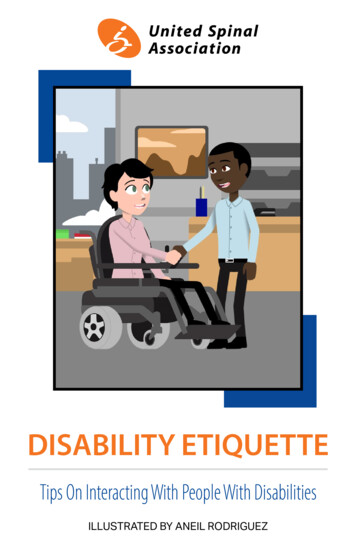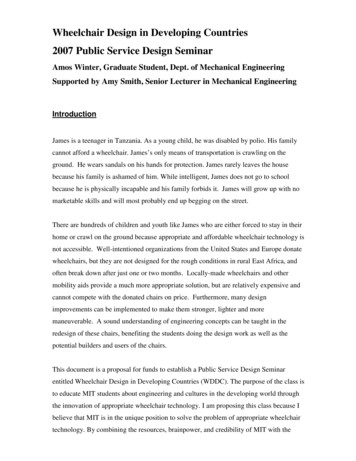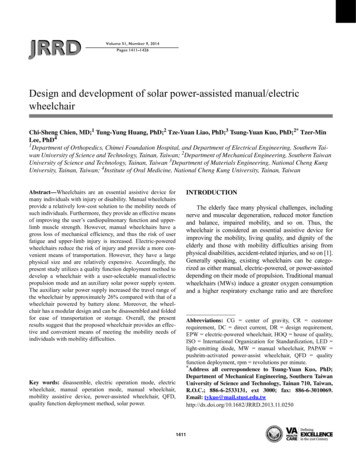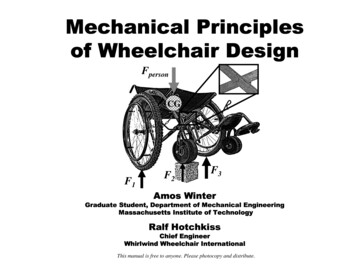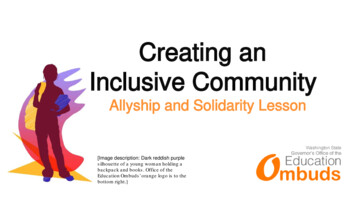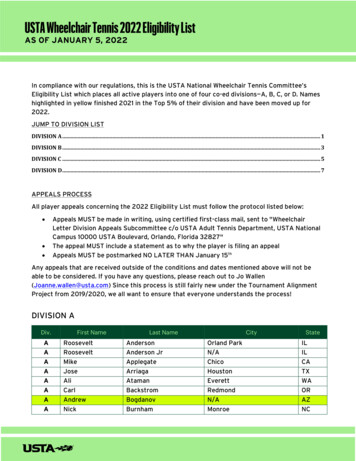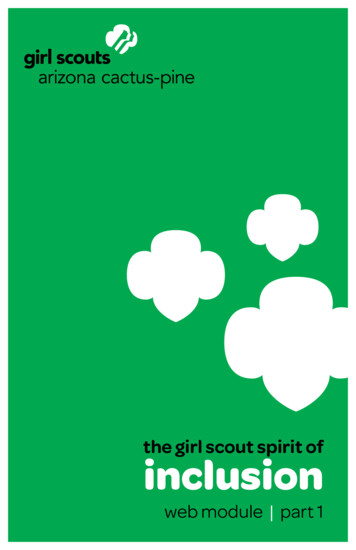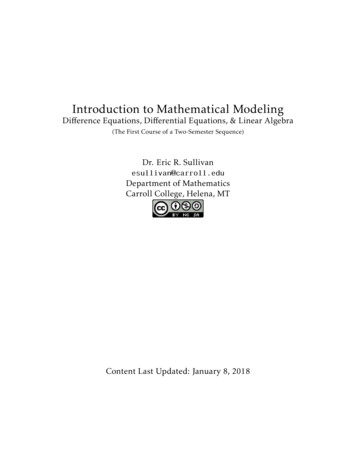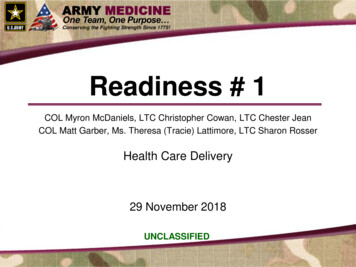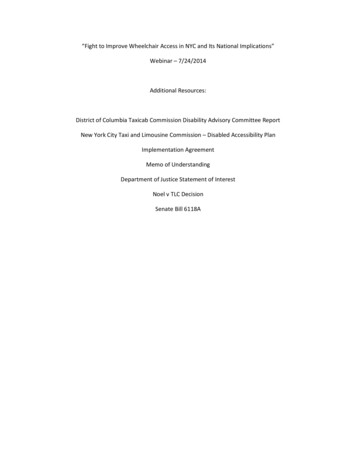
Transcription
“Fight to Improve Wheelchair Access in NYC and Its National Implications”Webinar – 7/24/2014Additional Resources:District of Columbia Taxicab Commission Disability Advisory Committee ReportNew York City Taxi and Limousine Commission – Disabled Accessibility PlanImplementation AgreementMemo of UnderstandingDepartment of Justice Statement of InterestNoel v TLC DecisionSenate Bill 6118A
DISTRICT OF COLUMBIATAXICAB COMMISSIONDISABILITY ADVISORYCOMMITTEEFebruary 20, 2014ComprehensiveReport andRecommendationson AccessibleTaxicab Service
EXECUTIVE SUMMARYOn July 10, 2012, the District of Columbia City Council passed the DC Taxicab Service ImprovementAmendment Act of 2012 (DC Taxi Act) to improve taxicab service in the District. Section 20f of the Actaddresses accessibility for individuals with disabilities, and requires the DC Taxicab Commission (DCTC) toestablish a Disability Taxicab Advisory Committee (the Committee) to advise the Commission on how to maketaxicab service in the District more accessible for individuals with disabilities. Under the DC Taxi Act, theCommittee was tasked with producing a comprehensive report and making recommendations to the Mayorand to the Council on 8 specific issues regarding accessible taxi service.A. Legal RequirementsIn 2012, taxis in the District of Columbia delivered an estimated 21 million tourists, business travelers,advocates, workers, and residents to their hotels, Hill visits, businesses, homes, places of worship, and otherdestinations. The rights of those tourists, travelers, workers and residents with disabilities to access taxi andsedan services in the District are guaranteed under the Americans with Disabilities Act (ADA) andcorresponding regulations, the DC Taxi Act, and the DC Human Rights Act (DCHRA).B. The Need for Accessible Taxi Service in the DistrictTaxis are an essential form of transportation for all individuals, but especially for individuals with disabilities.According to a 2002 study by the U.S. Bureau of Transportation Statistics, “Four times as many disabled peopleas nondisabled people lack suitable transportation options to meet their daily mobility needs.”i In DC, for nondisabled individuals, taxis are an important transportation alternative as a result of their availability and easeof use.Unfortunately, this is not currently the case for individuals with disabilities. In the District, there are only 20wheelchair accessible taxis out of the approximately 7,000 that operate in the District. This is equivalent toabout ¼ of 1 percent of the taxis in the District, and this low number is a very significant barrier to the manyindividuals with disabilities that live in or visit the District. And as was recently noted in a report on a localtelevision station, there is an additional barrier in getting taxis to even stop for, much less provide service to,individuals with disabilities.C. Other Jurisdictions Providing Accessible Taxi ServiceThere are efforts being made across the country by local advocates, city agencies and regional transportationagencies to increase the number of wheelchair accessible (“accessible”) taxis. A few other jurisdictions thatare working on improving their accessible taxi service include, for example, Arlington, VA; Baltimore, MD;Chicago, IL; Fairfax, VA; Montgomery County, MD; New York, NY; Prince George’s County, MD; and SanFrancisco, CA. These jurisdictions are utilizing a combination of federal funds, tax credits, incentives, andgovernmental requirements to support and increase the number of accessible taxicabs.D. Rapidly increasing Accessible Taxi Service in the DistrictRevisiting existing accessible fleet percentage requirements in the DC taxi and sedan laws would help to rapidlyincrease the number of accessible taxis in the District. Under the DC Taxi Act, and sedan regulations, each taxiand sedan company with 20 or more taxis in its fleet is required to dedicate a portion of its fleet to wheelchairaccessible taxis: at least 6 percent by December 31, 2014; at least 12 percent by December 31, 2016; and atleast 20 percent by December 31, 2018. The Commission may withhold license renewals for those companiesthat do not meet these requirements. However, the Committee calculates that meeting these minimumrequirements would only result in 3 percent of the D.C. taxi fleet being accessible by the end of 2018, and sothe Committee recommends that the required minimum percentage of accessible taxis in the covered fleets beincreased to 30 percent in 2016 and 40 percent in 2018.DC Taxicab Commission Disability Advisory Committee Accessible Taxicab Service Comprehensive Reporti P a g e
Digital dispatch companies should be required to offer service to all potential customers in the District,including individuals with disabilities, and the minimum fleet requirements for accessible vehicles should applyto digital dispatch companies as well. Digital dispatch companies who do not currently provide accessibleservice are only required to redirect customers in need of such service to a digital dispatch company that canaccommodate them.Additional measures could include: continuing to explore use of accessible taxis for provision of paratransitservice1,ii,iii; optimizing the usage of accessible taxis by permitting them to be used more than 8 hours per daywith different drivers; and creating a reciprocity agreement to expand inter-jurisdictional availability ofaccessible taxis in the District, Virginia, and Maryland.E and F. Current and Potential Financial Assistance and Incentives to Offset CostsTaxi companies and owner operators who want to purchase an accessible taxi currently have limited options.However, the Committee expects that these options will likely increase as a result of the requirements of theDC Taxi Act and similar demand in other jurisdictions.The DC City Council’s FY2014 Budget included an amendment that sets aside monies to increase the number ofaccessible taxis. For fiscal years 2014 and 2015 the first 4.7 million deposited in the DCTC Fund (a fiduciaryfund reliant upon taxi operator and passenger fees) is directed to be allocated to DCTC operations. Of theremaining funds, 750,000 is set aside to increase the number of wheelchair accessible vehicles in theDistrict. At this point it seems unlikely that the DCTC would reach the first threshold before next year.In addition, the DC Taxi Act creates a Public Vehicles-for-Hire Consumer Service Fund. These funds may beused by the DCTC to provide grants, loans, incentives, or other financial assistance to taxicab owners to offsetthe cost of acquiring, maintaining, and operating accessible vehicles.There are a variety of policy changes and incentives that the Committee believes would help supportincreasing the availability of accessible taxis in the District, such as: Allowing accessible taxis to remain in service as long as they pass inspection, rather than the usual agelimits;Allowing accessible taxis to pick up passengers in Maryland, Virginia and the District;Allowing accessible taxis to go to a separate, faster line at Union Station or area airports;Allowing accessible taxis to be used by multiple drivers for more than 16 hours in a 24 hour period;Providing a tax credit for accessible taxi owners;Negotiating the purchase of accessible taxis at a set price, and then passing along the savings when thetaxis are leased or sold to taxi owners;Waiving license fees for accessible taxi owners, or charging a fee for owners of non-accessible taxis;Creating a smartphone app for use of accessible taxi service as the District begins to increase thenumber of accessible taxis; andUsing accessible taxis to provide rides to paratransit or service program-eligible passengers.1Paratransit is defined in the ADA as a “comparable transportation service required by the ADA for individuals withdisabilities who are unable to use fixed route transportation systems.” Paratransit service must be origin-to-destinationservice and must be provided, at a minimum, within three-fourths of a mile on each side of a fixed route stop. Providersmay negotiate pick-up times within one hour before or after the passengers’ request. A fixed route system includespublic buses and subways, and is defined in the ADA as “a system of transporting individuals (other than by aircraft),including the provision of designated public transportation service by public entities and the provision of transportationservice by private entities, including, but not limited to, specified public transportation service, on which a vehicle isoperated along a prescribed route according to a fixed schedule.” The District provides paratransit service throughMetroAccess.DC Taxicab Commission Disability Advisory Committee Accessible Taxicab Service Comprehensive Reportii P a g e
In addition the District could utilize U.S. Department of Transportation Section 5310 funds; federal loans orloan guarantees; local budget grants; a tax credit; foundation funds and/or matches; and social impact bonds.G. Transitioning to a Fleet of 100 Percent Accessible TaxisThe Committee recommends a long-term goal of a 100 percent accessible taxi fleet in the District. A 100percent accessible taxi fleet allows for an inclusive, “universal design” of the system, allowing any taxi to beused by any individual – regardless of age, ability, or disability. Focusing on inclusive universal design alsochanges the paradigm of having to create and maintain two systems – one accessible, one not – in favor of oneunified system that everyone can use.A 100 percent accessible fleet can be achieved by working within the District’s current open entry taxisystem. While the existing open entry taxi system allows for greater flexibility among drivers entering themarket, additional regulations and incentives, enhanced training and public awareness, enforcement, andadministrative improvements are needed. The District should: Require dispatch companies, sedan companies and owners that do not currently provide accessibleservice to help support accessible service in the District.In conjunction with the DCTC’s age restrictions for taxis, require all new taxis that replace taxisremoved from service to meet an accessible taxi design standard (rather than requiring the purchaseof a specific vehicle). The standard should incorporate existing ADA requirements regarding space andsafety, and should also include vehicle requirements such as ramp location, as well as ramp orentrance height and slope requirements that are accessible for wheelchair and non-wheelchair usingpassengers who may require lower steps or slope.Utilize financing options identified (eg, Public Private Partnerships, a taxi company or dispatchprovider fee, federal matches) to purchase accessible taxis to lease or sell.Increase the age allowance for accessible taxis and/or allow them to remain in service for as long asthey pass inspection.Allow accessible taxis to go to a separate, faster line at Union Station or area airports.Introduce a tax credit for accessible taxi owners.Waive license or training fees for accessible taxi owners.Allow accessible taxis to be used by multiple drivers for more than 16 hours in a 24-hour period.Provide an annual award to a taxi driver of an accessible taxi for providing outstanding service.Use Universal Access Funds to create an Accessible Vehicle Lottery.In addition to the regular training curriculum, the training of DCTC drivers should include disability sensitivity,ADA 101, and operational and equipment training (use of restraints, seat belts etc. within the vehicle).Procedures and systems, along with responsible personnel, should be put into place and tasked withmonitoring compliance, providing technical assistance, and ensuring enforcement of the laws and regulationsregarding the accessibility of taxicabs, and progress toward the fully accessible taxi fleet goal.H. Plan, Feasibility, Costs, and Benefits for Requiring Aged-Out Taxis Replacement by Accessible TaxisBetween 2013 and 2017 all vehicles older than 7 years will be removed from service. The Committeerecommends the city update regulations requiring that new vehicles licensed starting in 2015 meet a minimumset of accessibility standards.DC Taxicab Commission Disability Advisory Committee Accessible Taxicab Service Comprehensive Reportiii P a g e
Replacing aged out vehicles with accessible vehicles is a feasible model for both rapidly increasing the numberof accessible taxis and achieving a 100 percent accessible fleet. The District could support the replacementprocess by exploring opportunities to negotiate a low price for a set number of accessible taxi vehicles andthen providing the taxis for lease, or by loan guarantees, tax credits or other incentives for the purchase ofnew accessible taxi vehicles. Alternatively, the District could provide increased incentives for the replacementof an older taxi vehicle with an accessible model for a limited time, for example 2014-2017, and beginrequiring accessible taxis in 2018.Additional outreach to companies, associations, independent owners/drivers and the newly formed unionshould be undertaken as soon as possible. The DCTC or the City Council Transportation Committee shouldhold stakeholder meetings to generate discussion and answer questions.Monetary costs to carry out this program are far outweighed by the foregone costs in city and local revenueand to the District’s reputation. Increased taxi ridership would lead to increased taxes for those who are ableto travel to work, revenue for the DCTC from the passenger surcharge, and city businesses. The city could savesignificant funds by allowing paratransit-certified riders to use taxis.Achieving a 100 percent accessible taxi fleet also realizes the first and third goals of the One City Action Planestablished in 2012: (1) Grow and Diversify the District Economy; and (3) Improve the Quality of Life forAll. Action 3.7.4 requires the District to work towards increasing the number of accessible taxis.Finally, the most significant benefit of establishing a 100 percent accessible taxi fleet is the acknowledgementof the worth and rights of all Americans, and that individuals with disabilities should have the same rights andprivileges to live and work in, and visit our nation’s capital.This Committee looks forward to continuing to provide support to the DCTC and the DC Council’sTransportation Committee to achieve the goal of a 100 percent accessible taxi fleet in the District.iiNational Council on Disabilities. (2005, June 13). The Current State of Transportation for People with Disabilities in theUnited States. Washington, DC: National Council on Disabilities. p. 19.ii49 CFR § 37.3 (1991)iii49 CFR § 37.121-155 (1991)DC Taxicab Commission Disability Advisory Committee Accessible Taxicab Service Comprehensive Reportiv P a g e
ContentsEXECUTIVE SUMMARY . iINTRODUCTION . 1A.THE LEGAL REQUIREMENTS FOR PROVIDING ACCESSIBLE TAXICAB SERVICE . 1I. The ADA and Taxis . 2II. Federal Laws & Opinions Requiring Purchase & Operation of Wheelchair Accessible Taxis . 2A. The ADA . 2B. Equivalent Service Requirements under the ADA. 2C. New York City Taxis and Department of Justice (DOJ) Opinion on Wheelchair Accessible Service. 3III. DC Law Requiring Purchase & Operation of Wheelchair Accessible Taxis. 3A. DC Taxi Act . 4B. DC Human Rights Act . 4IV. Accessible Taxi Service . 4A. Service without Discrimination . 4B. Passenger Use of Wheelchair Accessible Taxis . 5C. Accessible Communication . 5D. Training Requirements. 5E. Street Hails and Priority for Wheelchair Users. 5F. Dispatch Service for Wheelchair Accessible Taxis . 6V. Financing & Partnering Requirements . 6A. Financing Wheelchair Accessible Taxis . 6B. Wheelchair Accessible Taxis for Paratransit & Education-Related Transportation . 6VI. Wheelchair Accessible Vehicle Requirements . 6A. Wheelchair Accessible Taxis Defined . 6B. Space, Size, Securement & Lift Requirements for Accessible Vehicles. 7B.THE NEED FOR ACCESSIBLE TAXICAB SERVICE IN THE DISTRICT . 7I. People with Disabilities Need Increased Accessible Taxi Service. 7A. The Need for Increased Wheelchair Accessible Taxi Service . 8B. The Need for Increased Access to Taxi service for All People with Disabilities . 8II. Accessible Taxi Service in the District . 9Table B.1: Accessible Taxis and Population with Disability by Municipality . 10III. Benefits of Increased Access to Taxi Service . 11C.HOW OTHER JURISDICTIONS ARE PROVIDING ACCESSIBLE TAXI SERVICE. 12Table C: City and States Assessed . 12Accessible Taxicab Service Program Structures . 12D.TIMETABLE AND PLAN TO RAPIDLY INCREASE ACCESSIBLE TAXI AVAILABILITY . 16DC Taxicab Commission Disability Advisory Committee Accessible Taxicab Service Comprehensive Reportv P a g e
I. Revisit Existing Accessible Fleet Percentage Requirements in the DC Taxi and Sedan Laws. 17II. Continue to Explore Use of Accessible Taxis for Provision of Paratransit Service . 17III. Other alternatives . 18E.GRANTS, LOANS, INCENTIVES & REGULATORY MEASURES TO OFFSET THE COSTS OF PURCHASING,RETROFITTING, MAINTAINING AND OPERATING ACCESSIBLE TAXIS. 18I. DC’s Unique Taxi Industry . 18II. Vehicle and Operating Costs of Accessible Cabs . 19A. General Vehicle and Equipment costs . 19B. General Maintenance and Operating Costs . 20C. Sample Cost Data from DC’s rollDC Pilot Program. 20Table E.1: rollDC Continuation Funding Data . 20III. Financing and Incentives for Accessible Cabs in Other Jurisdictions . 21A. Arlington, VA . 21B. Baltimore, MD . 21C. Fairfax, VA . 21D. Prince George’s County, MD . 22E. Montgomery County, MD . 22F. Long Beach, CA . 22G. New York, NY . 22H. Chicago, IL . 23I. San Francisco, CA. 24Table E.2: Other Jurisdiction’s Funding and Incentives . 25IV. Federal and Local Incentives . 26A. New Freedom/Section 5310 . 26B. Additional Potential Public Funding . 27C. City/County Subsidies and Service Programs. 28D. Partnering with Public Agencies and Subsidies . 28E. City/County Regulation . 29F. Current DC Regulations and Financing Mechanisms. 30V. Potential Taxi Industry Incentives . 31Taxi Company and Taxi Commission Incentives. 31VI. Foundation Loans/Grants . 32F.RECOMMENDED GRANTS, LOANS, INCENTIVES & REGULATORY MEASURES TO OFFSET THE COSTS OFPURCHASING, RETROFITTING, MAINTAINING AND OPERATING ACCESSIBLE TAXIS . 32I. Regulatory Recommendations . 32A. Allow accessible taxis to remain in service as long as they pass inspection. 32B. Allow accessible taxis to pick up passengers in Maryland, Virginia and the District. . 33DC Taxicab Commission Disability Advisory Committee Accessible Taxicab Service Comprehensive Reportvi P a g e
C. Allow accessible taxis to go to a separate line at Union Station or area airports. . 33D. Allow accessible taxis to be used by multiple drivers for more than 16 hours in a 24 hour period. . 33II. Budgetary Recommendations . 33A. Introduce a tax credit for accessible taxi owners. . 33B. Purchase accessible taxis in bulk to be leased or sold to taxi owners and drivers. . 33III. Industry Recommendations . 33A. Wave license or training fees for accessible taxi owners. . 33B. Add a fee for non- accessible taxi owners. . 33C. Provide central dispatch for accessible taxi service, including partnering with third parties to use . 33smartphone app. . 33D. Utilize accessible taxis to provide rides to paratransit or service program-eligible passengers. . 34III. Potential Financing Option Scenarios . 34A. Open Entry . 34B. Closed Entry . 34G. PROPOSALS FOR BECOMING A 100 PERCENT ACCESSIBLE TAXI FLEET . 35I. Recent Statutory and Regulatory Changes . 35A. Wheelchair Accessibility . 35B. Features and Appearance . 35C. Driver Training . 36D. Age Limitations . 36Table G.2: UPCOMING REMOVAL SCHEDULE . 36II. Committee’s Recommended Proposal: Achieving a Fully Accessible Taxi Fleet Within the District’s. 36Current Open Entry Taxi System . 36A. Regulatory System Changes Necessary for Achieving a Fully Accessible Taxi Fleet . 37B. Regulatory Incentives toward a 100 Percent Accessible Taxi Fleet . 38C. Required Training . 39D. Public Awareness . 39E. Enforcement . 40F. Administrative Improvements. 40III. Proposal Two: Closed Entry Taxi System . 41A. Regulatory Requirements in a Closed System . 41B. Regulatory Incentives in a Closed System . 41C. Distribution of Permits or Medallions .
they pass inspection. Allow accessible taxis to go to a separate, faster line at Union Station or area airports. Introduce a tax credit for accessible taxi owners. Waive license or training fees for accessible taxi owners. Allow accessible taxis to be used by multiple drivers for more than 16 hours in a 24-hour period.
